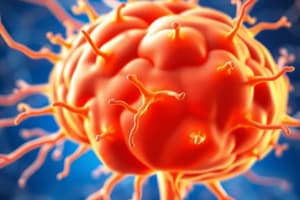Podcast
Questions and Answers
What is the role of the effector in a homeostatic system?
What is the role of the effector in a homeostatic system?
- Detect changes in a variable
- Regulate blood pressure
- Interpret input from the receptor
- Bring about changes to alter the stimulus (correct)
In a homeostatic system, which component is responsible for interpreting input from the receptor?
In a homeostatic system, which component is responsible for interpreting input from the receptor?
- Effector
- Receptor
- Nervous system
- Control center (correct)
Which type of feedback occurs less frequently than negative feedback in homeostatic systems?
Which type of feedback occurs less frequently than negative feedback in homeostatic systems?
- Normal feedback
- Dynamic feedback
- Static feedback
- Positive feedback (correct)
What is the main characteristic of positive feedback in a homeostatic system?
What is the main characteristic of positive feedback in a homeostatic system?
What happens if a homeostatic system fails according to the text?
What happens if a homeostatic system fails according to the text?
How are normal ranges for homeostatic variables determined according to the text?
How are normal ranges for homeostatic variables determined according to the text?
What is the main focus of cardiovascular physiology?
What is the main focus of cardiovascular physiology?
Which compound has 2 or more carbon atoms?
Which compound has 2 or more carbon atoms?
What is the function of nucleotides in DNA and RNA?
What is the function of nucleotides in DNA and RNA?
What is the primary function of pathologic anatomy?
What is the primary function of pathologic anatomy?
Which statement accurately describes acids?
Which statement accurately describes acids?
What are monomers of DNA and RNA composed of?
What are monomers of DNA and RNA composed of?
Flashcards are hidden until you start studying
Study Notes
Homeostatic Systems
- A homeostatic system consists of three components: receptor, control center, and effector.
- The receptor detects changes in a variable (stimulus), the control center interprets the input and initiates changes through the effector.
- The nervous system provides a quicker response, while the endocrine response is more sustained.
Homeostatic System Characteristics
- Dynamic system with a set point and a normal range for variables.
- Regulated through negative feedback to maintain homeostasis.
- If the system fails, homeostatic imbalance or disease results.
Normal Ranges for Homeostatic Variables
- Body temperature: 98.6°F.
- Blood glucose: 80–110 mg/dL.
- Blood pressure: 90–120/60–80 mm Hg.
Physiology
- Subdisciplines of physiology include cardiovascular physiology, neurophysiology, respiratory physiology, reproductive physiology, and pathophysiology.
- Physiologists examine the function of body structures, focusing on the molecular and cellular level.
Divisions of Physiology
- Pathologic anatomy examines macroscopic and microscopic anatomic changes resulting from disease.
- Radiographic anatomy investigates internal structures visualized by scanning procedures.
Matter, Energy, and Chemical Reactions
- Matter is made up of atoms, which are the smallest unit of matter.
- Inorganic compounds have 0 or 1 carbon atoms (e.g., NaCl, H2O, CO2).
- Organic compounds contain 2 or more carbon atoms (e.g., C6H12O6).
Properties of Water
- Solubility: many substances dissolve in water.
- Reactivity: water permits chemical reactions and participates in some reactions.
- High heat capacity: water can absorb and retain heat.
- Lubrication: water reduces friction between opposing surfaces.
Acids and Bases
- Acids dissociate in water to produce H+ and an anion (proton donor).
- Bases accept H+ when added to a solution (proton acceptor).
Monomers and Polymers
- Monomers: simple forms of organic compounds.
- Polymers: complex forms of organic compounds.
Amino Acid Chains
- Amino acid monomers are joined together by chemical bonds (peptide bonds).
- Dipeptides, tripeptides, or polypeptides are formed.
- Amino acid chains longer than about 100 amino acids are called proteins (e.g., hemoglobin, keratin).
Nucleic Acids
- DNA and RNA store and process information at the molecular level inside cells.
- DNA and RNA are made up of chains of monomers known as nucleotides.
- Nucleotides are composed of three molecules: a pentose sugar, a single nitrogenous base, and a phosphate group.
Studying That Suits You
Use AI to generate personalized quizzes and flashcards to suit your learning preferences.




